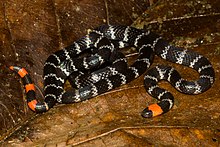Micrurus mipartitus (red-tailed coral snake[2] or many-banded coral snake)[3] is a species of coral snake in the family Elapidae.[2] The species is native to Central America and northern South America. The red-tailed coral snake is common in agricultural areas in Colombia.[4] Its highly neurotoxic venom is known to cause seizures in its prey by activating nerve proteins responsible for seizures within it.[5]
| Micrurus mipartitus | |
|---|---|
 | |
| Scientific classification | |
| Domain: | Eukaryota |
| Kingdom: | Animalia |
| Phylum: | Chordata |
| Class: | Reptilia |
| Order: | Squamata |
| Suborder: | Serpentes |
| Family: | Elapidae |
| Genus: | Micrurus |
| Species: | M. mipartitus |
| Binomial name | |
| Micrurus mipartitus | |
 | |
| Synonyms[2] | |
Elaps mipartitus | |
Subspecies
Five subspecies are recognized as being valid.[2]
- M. m. mipartitus (A.M.C. Duméril, Bibron & A.H.A. Duméril, 1854) – Pacific red-tailed coral snake
- M. m. anomalus (Boulenger, 1896) – Santa Marta red-tailed coral snake
- M. m. decussatus (A.M.C. Duméril, Bibron & A.H.A. Duméril, 1854) – Andean red-tailed coral snake
- M. m. popayanensis Ayerbe, M.A. Tidwell & M. Tidwell, 1990 – Popayan red-tailed coral snake
- M. m. rozei Golay, Chiszar, H.M. Smith & Breukelen, 1999 – Roze's red-tailed coral snake
Nota bene: A trinomial authority in parentheses indicates that the subspecies was originally described in a genus other than Micrurus.
Phenotypic features
M. mipartitus has a cylindrical body that can reach a total length (including tail) of 140.6 cm (55.4 in).[6] It has quite small eyes and a rounded head. The black body rings of this species can number from 34 to 84 and are separated by narrow yellow or white intermediary rings. The second ring on the head and 3 or 4 of the tail rings are red-colored in contrast to the white or yellow rings.[4]
Natural history
M. mipartitus is a species of crepuscular and nocturnal habits. During periods of low rainfall, it may be located underground, several centimeters deep. In times of high rainfall, it is found on the soil surface or where leaf litter is abundant. This coral snake lives in forests, from tropical dry forests to foggy forests, and is also found in human settlements in rural areas used for agriculture.[7]
The diet of M. mipartitus is mainly based on snakes (e.g., Atractus werneri, A. sanctamartae, Leptotyphlops spp.) as well as lizards (e.g., Lepidoblepharis sanctaemartae), amphisbaenids (e.g., Amphisbaena spp.), frogs, and caecilians (e.g., Caecilia guntheri). It is oviparous; about eight white-colored eggs have been recorded, which are 2.9 cm (1.1 in) long, with an average weight of 3.1 g (0.11 oz). Incubation period lasts between 73–87 days, total length of each hatchling varies from 20–21.9 cm (7.9–8.6 in) and weight is around 3.3 g (0.12 oz).[7]
Range
It occurs in Central America and South America.[1][2][3] Limits of its range vary by source and may include Nicaragua[3] and Costa Rica[2] in the north, although older records from Nicaragua and Costa Rica likely refer to M. multifasciatus.[2] The IUCN Redlist restricts its range to Panama, Colombia, Venezuela, and Ecuador, and possibly Peru.[1] It has also been listed from Brazil (Rondônia).[2]
Venom
The red-tailed coral snake has a potentially deadly neurotoxic venom, which produces a complete depolarizing muscle block.[8] Proteomics analysis of the venom components found that it contains about 60% three-finger toxins, 30% phospholipase A2, and 10% other toxins.[9] The most abundant venom component is the three-finger toxin mipartoxin-I.[10]
The venom acts by blocking the neuromuscular transmission of nerve muscle preparations, it acts in a post-synaptic way through the Nicotinic acetylcholine receptor (nAChr), inhibiting the muscle contractions in phrenic nerve diaphragm.[11] After the bite, local pain and paraesthesia appear in minutes, in severe cases, neurological manifestations appear in 30 minutes to 1–2 hours, such as progressive bilateral ptosis, dysarthria, progressive weakness in the muscles of the extremities, difficulties in walking, salivation, drowsiness, respiratory arrest, flaccid quadriparesis and severe flaccid quadriplegia. The LD50 for 18-20 gram mice is 9 μg and 0.45 mg / kg. The intraperitoneal lethal dose is 0.125 mg / kg and 0.06 μg / g.[4][12]
